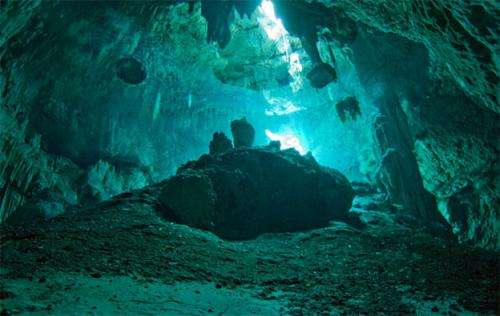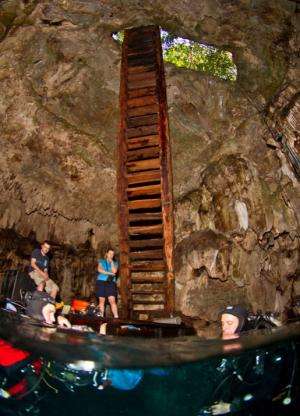Skeleton found in Mexican cave yields clues about first human movement in Americas

The stunning and dangerous underwater caves of Mexico's Yucatan Peninsula have yielded a remarkable find that could provide clues to the early movements of mankind: a fully intact skeleton of an adolescent girl, dating back some 13,000 years ago.
The remains of the girl, known as Naia, have provided rich genetic information, extracted from a molar, which will help to end a longstanding debate about the origin of the first people to inhabit the Americas and their possible connection to native people today.
A team of international scientists, including McMaster geography and earth sciences professor Ed Reinhardt, reported the findings May 15 in the journal Science.
They believe the girl met her fate when she ventured into the elaborate cave system, which was dry at that time in human history, and fell approximately 160 feet into a subterranean pit which would become an inescapable natural trap.
"We don't know for sure, but she probably entered the cave willingly, likely with a torch, in search of groundwater," says Reinhardt, who is the only Canadian scientist who has dived within the cave system. "She would have survived the fall because there was some water in the pit of the cave, only to die a horrible death of starvation."
Thousands of years later, her skeleton was found alongside the remains of ancient animals, some of them extinct, including a sabre tooth cat, an elephant-like creature called a gomphothere, a giant ground sloth, fruit bats, and others.

"This is really a stunning site in the sense that the water is so clear and our lights just illuminate the white limestone. It's just like a cathedral," he says. "But in contrast, when you think about what actually occurred here, there is a horrific aspect to the cave."
Reinhardt and his team took core samples from the pit and analyzed the sediment, microfossils and ways the water chemistry changed through time, to reconstruct the flooding history of the cave system. In doing that, they helped to date the skeleton.
They showed that humans and animals could only have entered the cave before glaciers melted and sea levels rose, flooding the caves.
The findings are significant because scientists have long debated the origins of the first Americans. Most accept the view that the original immigrants crossed over a land bridge that once connected northeast Asia to present-day Alaska.
A few ancient remains have baffled scientists, however, because their skulls are narrower and have other measurably different features than those of Native Americans. Some researchers have suggested that these migrants came to the Americas from as far away as Australia or Southeast Asia. But genetic analysis from researchers at Washington State University found a link between the skeleton and modern Native Americans, supporting the theory they are a population that has evolved over time in the Americas.
Reinhardt believes the cave can still provide many more answers to outstanding questions, some of them involving the extinct animal remains found in the pit.
"We have a whole collection of bones at the bottom and while much of the research is focused on the human skeleton, we still don't have a good understanding of the other animals," says Reinhardt. "There are a lot of questions about these megafauna, or large animals, which went extinct some 13,000 years ago. What was the cause? Was it humans who were killing them off? Or a meteor impact that caused climate change? There are a lot questions to answer," he says.
The research was an international effort, involving scientists, divers and technicians from more than a dozen institutions.
More information:
phys.org/news/2014-05-genetic- … girl-dating-dna.html
Provided by McMaster University